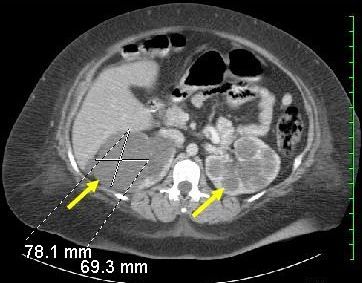- Clinical Technology
- Adult Immunization
- Hepatology
- Pediatric Immunization
- Screening
- Psychiatry
- Allergy
- Women's Health
- Cardiology
- Pediatrics
- Dermatology
- Endocrinology
- Pain Management
- Gastroenterology
- Infectious Disease
- Obesity Medicine
- Rheumatology
- Nephrology
- Neurology
- Pulmonology
Autosomal Dominant Polycystic Kidney Disease in a 38-Year-Old Woman
Autosomal dominant polycystic kidney disease (ADPKD) is common. Presenting symtpoms include hypertension, hematuria, proteinuria, and renal insufficiency.
A 38-year-old woman presented with a 10-day history of bilateral lower extremity swelling. She also noted dyspnea on exertion and orthopnea. Her past medical history was significant for uterine cancer; she had undergone a hysterectomy and bilateral salpingo-oophorectomy 5 years earlier. Subsequent to that surgery, the patient never had any medical check-ups and took no medications. She was born in Guatemala and moved to the United States 6 years ago. Her mother and her brothers had hypertension and “kidney problems.” Her uncle was receiving dialysis.
On physical examination in the emergency department, the patient’s vital signs were normal except for a blood pressure of 160/100 mm Hg. Cardiac examination revealed no murmurs or gallops. There was no jugular venous distention. Abdominal examination revealed moderate fullness; there was no tenderness to palpation. Kidney function was normal; the creatinine level was 0.9 mg/dL. Urinalysis showed no dysmorphic red blood cells or significant proteinuria. Duplex venous ultrasound of legs revealed no deep venous thrombosis. Transthoracic echocardiography demonstrated normal systolic and diastolic functions.

The patient underwent abdominal and pelvic CT scanning with contrast for evaluation of an abdominal mass, which showed innumerable cystic lesions in both kidneys, suggestive of polycystic disease (Figure). There was no evidence of recurrent malignancy.
Given the family history and imaging findings, the diagnosis of autosomal dominant polycystic kidney disease (ADPKD) was made.
Therapy with lisinopril was initiated, which helped established better blood pressure control. The patient was advised to obtain genetic counseling and outpatient follow-up.
Discussion
ADPKD is a common disorder: it occurs in approximately 1 of every 400 to 1000 live births.1,2 Approximately 85% of families with ADPKD have an abnormality on chromosome 16 (PKD1 locus).3 The remainder has a different genetic defect on chromosome 4 (the PKD2 locus).
Patients with ADPKD can present with hypertension, hematuria, proteinuria, or renal insufficiency. Flank pain secondary to renal hemorrhage, calculi, or urinary tract infection is the most common symptom.4 ADPKD is also associated with cerebral aneurysms, hepatic cysts, mitral and aortic valve prolapse, colonic diverticular disease, pancreatic cysts, and thoracic and abdominal aortic aneurysms.5
Intracranial aneurysms (ruptured and incidentally detected aneurysms) occur in 5% of patients with ADPKD. The most important risk factor for intracranial aneurysm in patients with ADPKD is a family history of this vascular lesion. The risk for development of aneurysm in this setting increases to 20% in patients with a family member who has had a ruptured aneurysm and is highest in those with a first-degree relative who has had a ruptured aneurysm. All patients with a family history of intracranial aneurysm, particularly ruptured aneurysm, should undergo screening.6
The diagnosis of ADPKD relies principally on imaging of the kidney.4 The diagnosis of ADPKD by ultrasonographic criteria depends on the number of cysts, age groups, and risk for genotype of ADPKD.5
Increased renin-angiotensin system activity and extracellular volume expansion play an important role in the pathogenesis of hypertension in patients with ADPKD. Thus, patients usually respond well to ACE inhibitors.7 No specific treatment has been proven to prevent or delay progression of ADPKD. However, promising specific therapies that are being evaluated include vasopressin receptor antagonists and increasing fluid intake to suppress plasma vasopressin levels.8
Patients with ADPKD and end-stage renal disease are usually treated with hemodialysis or renal transplant. Outcomes are equivalent or better overall than for those patients without ADPKD.9
References:
1. Gabow PA. Autosomal dominant polycystic kidney disease. N Engl J Med. 1993;329:332-342.
2. Levy M, Feingold J. Estimating prevalence in single-gene kidney diseases progressing to renal failure. Kidney Int. 2000;58:925-943.
3. Harris PC, Torres VE. Autosomal dominant polycystic kidney disease. Gene Clinics Online Reviews at Gene Tests-Gene Clinics. Seattle: University of Washington; 2002.
4. Torres VE, Harris PC, Pirson Y. Autosomal dominant polycystic kidney disease. Lancet. 2007;369:1287-1301.
5. Chapman AB. Approaches to testing new treatments in autosomal dominant polycystic kidney disease: insights from the CRISP and HALT-PKD studies. Clin J Am Soc Nephrol. 2008;3:1197-1204.
6. Ring T, Spiegelhalter D. Risk of intracranial aneurysm bleeding in autosomal-dominant polycystic kidney disease. Kidney Int. 2007;72:1400-1402.
7. Schrier RW. Renal volume, renin-angiotensin-aldosterone system, hypertension, and left ventricular hypertrophy in patients with autosomal dominant polycystic kidney disease. J Am Soc Nephrol. 2009;20:1888-1893.
8.Torres VE. Role of vasopressin antagonists. Clin J Am Soc Nephrol. 2008;3:1212-1218.
9. Perrone RD, Ruthazer R, Terrin NC. Survival after end-stage renal disease in autosomal dominant polycystic kidney disease: contribution of extrarenal complications to mortality. Am J Kidney Dis. 2001;38:777-784.
